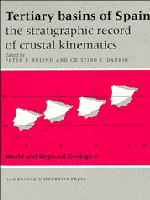Book contents
- Frontmatter
- Contents
- List of contributors
- Preface
- Dedication to Professor Oriol Riba IArderiu
- Memorial, Etienne Moissenet 1941–1994
- PART G GENERAL
- PART E EAST
- PART W WEST
- PART C CENTRE
- C1 Structure and Tertiary evolution of the Madrid basin
- C2 Neogene tectono-sedimentary review of the Madrid basin
- C3 Sedimentary evolution of lake systems through the Miocene of the Madrid Basin: paleoclimatic and paleohydrological constraints
- C4 Paleomorphologic features of an intra-Vallesian paleokarst, Tertiary Madrid Basin: significance of paleokarstic surfaces in continental basin analysis
- C5 Tectono-sedimentary analysis of the Loranca Basin (Upper Oligocene–Miocene, Central Spain): a ‘non-sequenced’ foreland basin
- C6 Paleoecology and paleoclimatology of micromammal faunas from Upper Oligocene – Lower Miocene sediments in the Loranca Basin, Province of Cuenca, Spain
- C7 Fluvial fans of the Loranca Basin, Late Oligocene – Early Miocene, central Spain
- C8 Saline deposits associated with fluvial fans, Late Oligocene – Early Miocene, Loranca Basin, Central Spain
- C9 Shallow carbonate lacustrine depositional controls during the Late Oligocene – Early Miocene in the Loranca Basin (Cuenca Province, central Spain)
- PART S SOUTH
- Index
C6 - Paleoecology and paleoclimatology of micromammal faunas from Upper Oligocene – Lower Miocene sediments in the Loranca Basin, Province of Cuenca, Spain
Published online by Cambridge University Press: 04 August 2010
- Frontmatter
- Contents
- List of contributors
- Preface
- Dedication to Professor Oriol Riba IArderiu
- Memorial, Etienne Moissenet 1941–1994
- PART G GENERAL
- PART E EAST
- PART W WEST
- PART C CENTRE
- C1 Structure and Tertiary evolution of the Madrid basin
- C2 Neogene tectono-sedimentary review of the Madrid basin
- C3 Sedimentary evolution of lake systems through the Miocene of the Madrid Basin: paleoclimatic and paleohydrological constraints
- C4 Paleomorphologic features of an intra-Vallesian paleokarst, Tertiary Madrid Basin: significance of paleokarstic surfaces in continental basin analysis
- C5 Tectono-sedimentary analysis of the Loranca Basin (Upper Oligocene–Miocene, Central Spain): a ‘non-sequenced’ foreland basin
- C6 Paleoecology and paleoclimatology of micromammal faunas from Upper Oligocene – Lower Miocene sediments in the Loranca Basin, Province of Cuenca, Spain
- C7 Fluvial fans of the Loranca Basin, Late Oligocene – Early Miocene, central Spain
- C8 Saline deposits associated with fluvial fans, Late Oligocene – Early Miocene, Loranca Basin, Central Spain
- C9 Shallow carbonate lacustrine depositional controls during the Late Oligocene – Early Miocene in the Loranca Basin (Cuenca Province, central Spain)
- PART S SOUTH
- Index
Summary
Abstract
In the Loranca Basin, sediments are exposed ranging in age from the Middle Eocene to the Turolian. The fossil micromammal record of this considerable time interval is, however, not continuous. For paleoecological study we have chosen a composite section in the Rio Mayor valley where stratigraphical control allows us to superpose six faunas, dating from the Late Oligocene to the Early Miocene. In this interval, which covers some 4–5 million years, two relatively dry, and two relatively humid, periods are recognized.
Introduction
A first attempt at a paleoecological approach to Spanish micromammal faunas was made by Van de Weerd & Daams (1978), who recognized an alternation of relatively humid and dry periods during the Neogene of the Calatayud–Teruel Basin. Daams & Van der Meulen (1984) further developed the model, and constructed relative humidity and temperature curves for part of the Neogene of North Central Spain. Additional information and the application of principal component analysis subsequently resulted in the construction of more-detailed relative-humidity and temperature curves (Van der Meulen & Daams, 1992) for part of the Neogene of the Calatayud–Teruel Basin.
The Upper Oligocene and Lower Miocene of the Loranca Basin also yielded numerous micromammal faunas, but our taxonomical study is unfortunately not advanced enough for principal component analysis or the construction of detailed climatic curves. For this study, we have chosen a succession of six localities, which are all located in the Rio Mayor valley and whose stratigraphic position can be controlled lithostratigraphically (Fig. 1).
- Type
- Chapter
- Information
- Tertiary Basins of SpainThe Stratigraphic Record of Crustal Kinematics, pp. 295 - 299Publisher: Cambridge University PressPrint publication year: 1996
- 2
- Cited by



